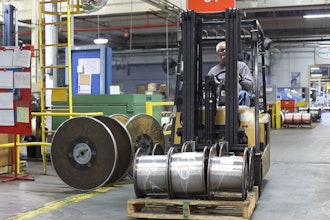Pressure gauges have been a reliable source of accurate pressure measurement for more than 100 years. The operation and design of pressure gauges dates back to the mid 1800s when Eugene Bourdon invented the Bourdon tube. This same principle is used today, albeit with enhancements to last longer and resist corrosion. Many factors affect proper gauge selection, and if you follow the seven-step process, the task can become simpler and more exact.
Step 1: Process media
While all factors regarding gauge selection are important, consideration for the actual process media that the gauge will be exposed to is vital. Bourdon tubes are most often manufactured from phosphor bronze, 316 stainless steel, monel and inconel. When the available Bourdon tube materials can accommodate a particular process, there are generally no other complications in the selection process. However, when available Bourdon-tube materials cannot satisfy an application, a diaphragm seal can be used in conjunction with a pressure gauge to prevent the process media from contacting the bourdon tube.
The design and nature of a diaphragm seal allow for the introduction of many more materials than can be used in manufacturing of Bourdon tubes. By selecting the proper diaphragm and bottom housing for the diaphragm seal the only parts exposed to the process you can satisfy nearly all applications. The diaphragm seal not only protects a pressure gauge from corrosion attack, it also prevents viscous or dirty media from clogging the bourdon tube. The diaphragm seal will typically add to the gauge accuracy an additional 0.5% of the full scale.
If the process temperature affects the gauge performance, a capillary line can be used to reduce the temperature. Also, steam applications will require the use of a siphon that must be filled with water before assembled to the gauge and process.
Step 2: Process pressure
It is important to know if the process pressure is static or dynamic. If a pressure gauge sees a constant pressure continuously, then typically, that pressure gauge will last for years without degradation of performance. However, most pressure-gauge applications are dynamic in nature, and will cause gauge failure unless appropriate measures are taken.
System operating pressure generally determines the selection of the proper pressure-gauge range, which should be twice the normal operating pressure. If fluctuating pressures are present, as in the case of pulsation caused by a pump or compressor, or if gauges will be subjected to severe service, they should be liquid filled and dampened to reduce Bourdon-tube stresses. Other product features and accessories can be used to minimize stress and extend the life of the pressure gauge. These include internal throttle screws, pulsation dampeners and pressure snubbers.
Step 3: Environment
Various environmental conditions can affect pressure-gauge performance. These include vibration, ambient temperature, and harsh conditions. Vibration can cause excessive movement wear, which results in pressure-gauge failure. It also makes it difficult to read the pressure gauge because the pointer is oscillating. To help prevent these problems, pressure gauges are often filled with a dampening fluid such as glycerin. Many plant-maintenance and safety engineers have adopted liquid-filled gauges with throttle screws as a standard for all applications. Remote-mounting the gauge off the process will also remove the effects of vibration.
Ambient temperature affects pressure-gauge accuracies in at least two ways. First, as temperature increases, the bourdon-tube material modulus decreases. This results in a lighter spring rate of the tube. Therefore, the gauge will tend to indicate higher pressure as temperature increases. The converse is also true: As temperature decreases, the tube material modulus increases, and the gauge reading will tend to read lower than actual. Virtually all pressure gauges are affected by this phenomenon, except those manufactured with constant modulus materials that tend to be expensive and more difficult to work with.
For liquid-filled pressure gauges that have uncompensated cases, accuracy errors can be introduced even with as little as 10 degrees F change in temperature. Under this condition, the potential for error is a result of internal case pressure build-up from an increase in temperature; this will cause a downscale pointer shift (the opposite will be true with a decrease in temperature). This potential for case pressure error will be present in pressure ranges of 100 psi and lower. When harsh (corrosive or dusty) conditions exist, hermetically sealed and/or liquid-filled pressure gauges should be specified. Either of these designs will prevent foreign elements from entering the case and adversely affecting gauge operation.
Step 4: Accuracy
Before selecting a pressure gauge for accuracy, you need to first understand that accuracy is the conformity of a pressure gauge reading to an accepted standard, such as a deadweight tester. Inaccuracy is the difference (error) between the true value and the indication expressed as a percent of the span. Total accuracy error includes hysteresis and repeatability errors. Grades of accuracy are provided in ASME B40.1. They range from grade D (± 5.0%) to grade 4A, (±0.1%) of full scale. Because some grades of accuracy are not expressed as full scale, ASME B40.1 section 3.4 should be consulted for details.
For accuracy, pressure-gauge selection must consider a number of trade-offs, including durability, price, dial size and materials of construction. While specific accuracy requirements differ, consider the following usage guidelines:
• test gauges and standards: 0.25% through 0.10%
• critical processes: 0.5%
• general industrial processes: 1.0%
• less critical commercial applications: 2.0%
Step 5: Size
Dial diameters of pressure gauges range from 1.5 in. to 16 in. Size is generally determined by readability requirements. If the gauge is remote from the operator, a larger dial is necessary. For gauges mounted on a panel close to an operator, smaller sizes are often acceptable.
More accurate pressure gauges generally have larger dials, since more dial graduations are needed to read the higher degree of accuracy. Therefore, for most test gauges having accuracies of 0.25% or better, the 4.5-in. dial is the smallest selected, while 6-in. and larger gauges are more common. Downsizing of equipment and space limitations will often dictate the use of smaller dial sizes. However, these gauges should not be selected for dial size only. Remember the other six selection criteria that exist to ensure the proper pressure gauge is being selected.
Step 6: Connections
In North America, 1/4 and 1/2 NPT tapered pipe threads are the most common connections used for pressure gauges. Process pressure gauges with 4.5-in. dial sizes or larger are most often supplied with a 1/20 NPT connection. This is particularly true when these gauges are stem-mounted directly and liquid-filled, because the larger-size gauge socket will support the pressure gauge better. For dial sizes smaller than 4.5 in, a 1/4 NPT is typical, while in some cases a 1/8 NPT will be used. For pressure-gauge dial sizes smaller than 2 in., a 1/8 NPT is most common.
Many other threaded gauge connections are used by certain industries. For example, SAEJ514 straight thread is used for many hydraulics applications, while SAE flared connections are used for some refrigeration installations. A number of considerations are made when selecting a pressure gauge connection, including pressure, gauge size and weight, space limitations and leak integrity.
Step 7: Mounting
Pressure gauges are mounted in the following ways:
• Direct stem mount, lower or back connect
• Remote wall/surface mount, lower connect
• Panel surface mount, back connect
• Panel hole, U-clamp, flush-mount, back connect
• Panel hole, front flange, flush-mount, back connect
While the majority of pressure gauges are supplied with lower connections for stem mounting, it is still important to know how a pressure gauge will be mounted when installed. For example, when a pressure measurement is needed for a piece of equipment that has severe vibration, it may be necessary to remotely mount the pressure gauge. This can be done easily, but you must ensure that the gauge has a back-mounting flange. In cases when the gauge is inherently designed to be surface mounted, it will also be necessary to use a length of capillary to attach the gauge and equipment.
In the case of a pressure gauge that must be mounted in a panel, there are several options. First, the most common method is to use a U-clamp to mount the gauge when access to the rear of the panel is possible.
Second, a three-hole front flange can be used to panel-mount a gauge from the front when there is limited or no access to the rear of the panel. In both of these situations, it is necessary to cut a hole in the panel to allow the gauge to be recessed into the panel.
The third and least-used method is to mount the pressure gauge on the panel (not through the panel) with only a small hole in the panel for the connection to the socket. In this case, the gauge must be suitable for surface mounting.


















